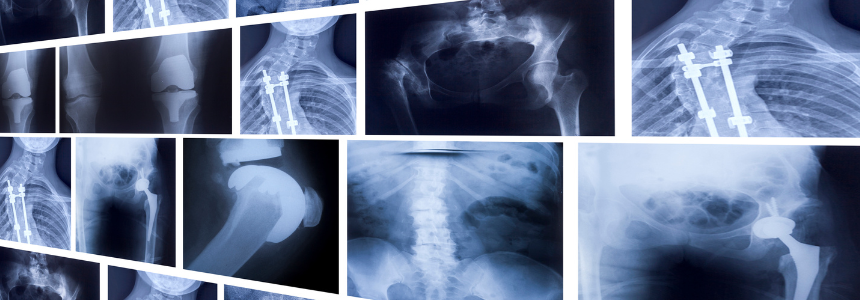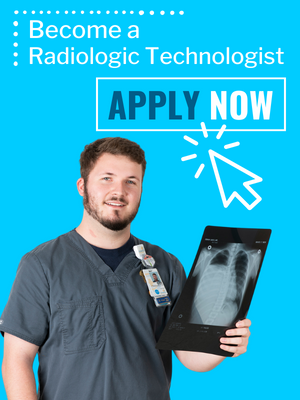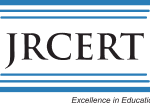
RADIOGRAPHY DEGREE
It’s more than just an x-ray.
The Radiography curriculum prepares the graduate to be a radiographer, a skilled healthcare professional who uses radiation to produce images of the human body.
Course work includes clinical rotations to area healthcare facilities, radiographic exposure, image processing, radiographic procedures, physics, pathology, patient care and management, radiation protection, quality assurance, anatomy and physiology, and radiobiology.
Graduates of accredited programs are eligible to apply to take the American Registry of Radiologic Technologist’s national examination for certification and registration as medical radiographers. Graduates may be employed in hospitals, clinics, physician’s offices, medical laboratories, government agencies, and industry.
Degree & Pathway Completion Plans
View what classes you need and when you can take them to complete a degree in Radiography.

Where Can I Transfer?
Looking to transfer to a university after you complete your degree at Carteret CC? Good news! Carteret CC has university transfer agreements for students who gradate with an Associate of Applied Science degree in Radiography to:
Cabarrus College of Health Sciences
Carolinas College of Health Sciences
East Tennessee State University
A DAY IN THE LIFE OF A RADIOGRAPHY STUDENT
IMPORTANT DOCUMENTS
Admission Requirements
Admission Checklist
RAD Program Manual 2023-2025
HELPFUL LINKS
Program Admissions Testing
Program Clinical Requirements
ADDITIONAL PROGRAM INFO
PROGRAM CONTACT
Elaine Postawa
Chair of Radiography
Phone: (252) 222-6165
Email: postawae@carteret.edu
PROGRAM MISSION, VISION, AND STUDENT LEARNING OUTCOMES
MISSION STATEMENT
Carteret Community College’s Radiography Program is dedicated to the delivery of a quality education in radiography through continuous program improvement and actualization of program goals while fostering life-long learning. Through an outcome-focused learning environment, the program will provide our healthcare community with competent, compassionate, professional entry-level radiographers who are prepared to sit for the American Registry of Radiologic Technologists (ARRT) examination, secure employment in field, and engage in professional growth and development.
VISION
Striving to maintain program quality and elevate community awareness while enhancing and diversifying instructional methods and transitioning faculty.
GOALS & STUDENT LEARNING OUTCOMES
Program Goal #1
Students will possess the knowledge and clinical competency skills of an entry-level radiographer.
Student Learning Outcomes in support of goal 1:
1.1 Students will apply radiographic positioning knowledge and skills to accurately demonstrate the anatomy of interest.
1.2 Students will perform radiographic exams in a time frame consistent with clinical standards.
Program Goal #2
Students will communicate effectively.
Student Learning Outcomes in support of goal 2:
2.1 Students will demonstrate effective oral communication skills in the clinical setting using age appropriate instructions and explanations on procedures performed in the clinical setting.
2.2 Students will demonstrate written communication skills addressing clinical content.
Program Goal #3
Students will demonstrate critical thinking skills.
Student Learning Outcomes in support of goal 3:
3.1 Students will possess the knowledge and ability to adapt positioning skills to various patient conditions and clinical situations.
3.2 Students will evaluate images for proper positioning, demonstration of anatomy and image quality and will make adjustments as needed to obtain a diagnostic radiograph.
PROGRAM COMPLETION RATE
The program completion rate is calculated for those students who fail to complete due to academic reasons. Students who attrite due to nonacademic reasons such as: 1) financial, medical/mental health, or family reasons, 2) military deployment, 3) a change in major/course of study, and/or 4) other reasons an institution may classify as nonacademic withdrawal are not included when calculating the program completion rate.
PROGRAM ACCREDITATION
The Associate Degree Radiography program at Carteret Community College has full 8-year accreditation status by the Joint Review Committee on Education in Radiologic Technology. The program is scheduled for a reaccreditation site visit during the second quarter of 2023.
Joint Review Committee on Education in Radiologic Technology (JRCERT)
20 N. Wacker Drive, Suite 2850
Chicago, IL 60606-3182
312-704-5300
jrcert.org
Accreditation Status
JRCERT RAD Standards 2021
JRCERT Program Effectiveness Data
JRC Assessment Plan




